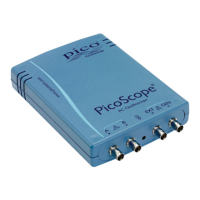Prog ramming the 3000A Series oscilloscopes38
Copyright © 2011-2013 Pico Technology Limited. All rights reserved.ps3000abpg.en r9
2.12.15
ps3000aGetTimebase
PICO_STATUS ps3000aGetTimebase
(
short handle,
unsigned long timebase,
long noSamples,
long * timeIntervalNanoseconds,
short oversample,
long * maxSamples,
unsigned short segmentIndex
)
This function calculates the sampling rate and maximum number of samples for a given
timebase under the specified conditions. The result will depend on the number of
channels enabled by the last call to ps3000aSetChannel.
This function is provided for use with programming languages that do not support the
float data type. The value returned in the timeIntervalNanoseconds argument
is restricted to integers. If your programming language supports the float type, then
we recommend that you use ps3000aGetTimebase2 instead.
To use ps3000aGetTimebase or ps3000aGetTimebase2, first estimate the timebase
number that you require using the information in the timebase guide. Next, call one of
these functions with the timebase that you have just chosen and verify that the
timeIntervalNanoseconds argument that the function returns is the value that
you require. You may need to iterate this process until you obtain the time interval
that you need.
handle, the handle of the required device.
timebase, see timebase guide
noSamples, the number of samples required.
* timeIntervalNanoseconds, on exit, the time interval between
readings at the selected timebase. Use NULL if not required.
oversample, not used.
* maxSamples, on exit, the maximum number of samples available.
The result may vary depending on the number of channels enabled
and the timebase chosen. Use NULL if not required.
segmentIndex, the index of the memory segment to use.
PICO_OK
PICO_INVALID_HANDLE
PICO_TOO_MANY_SAMPLES
PICO_INVALID_CHANNEL
PICO_INVALID_TIMEBASE
PICO_INVALID_PARAMETER
PICO_SEGMENT_OUT_OF_RANGE
PICO_DRIVER_FUNCTION

